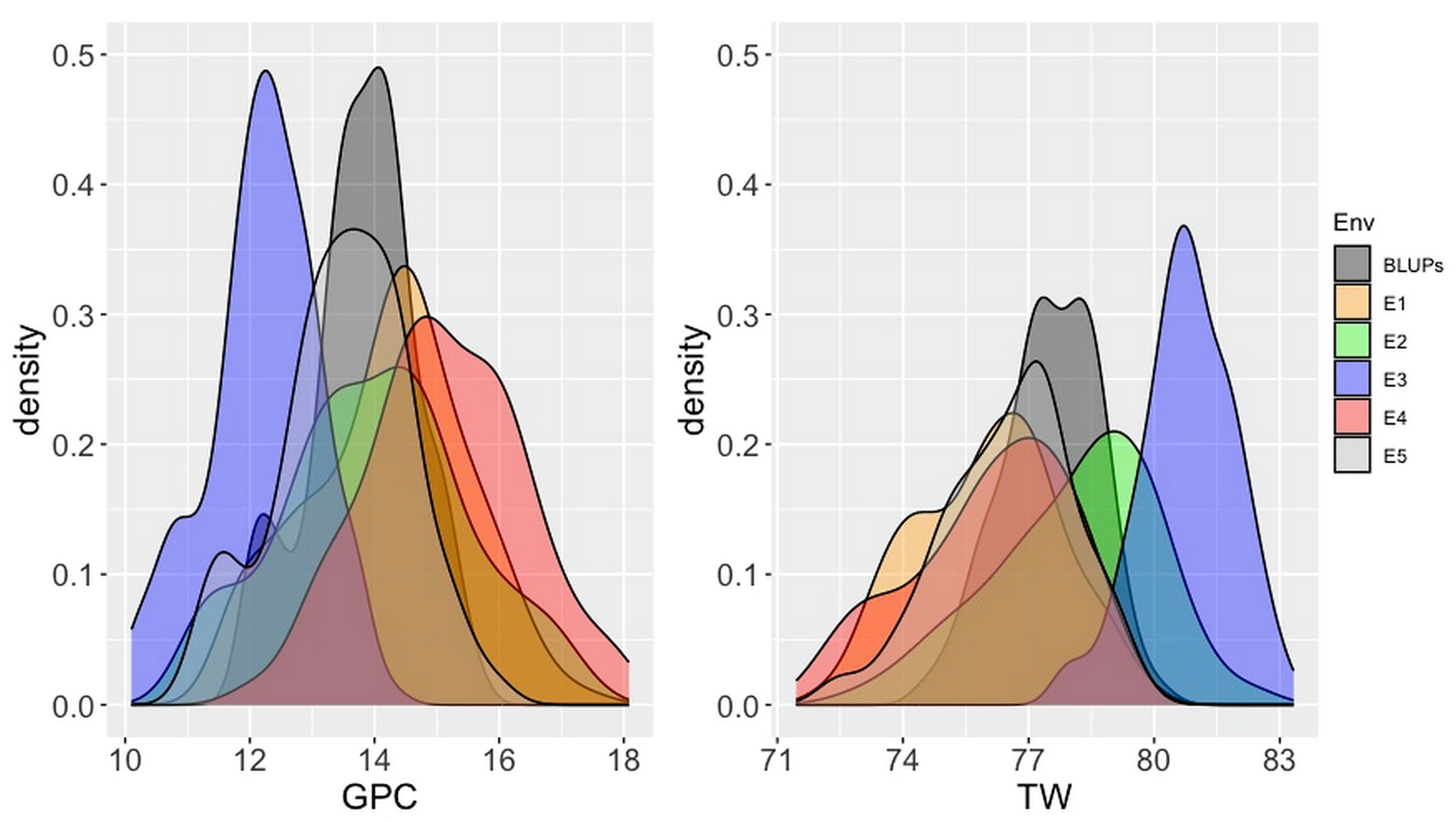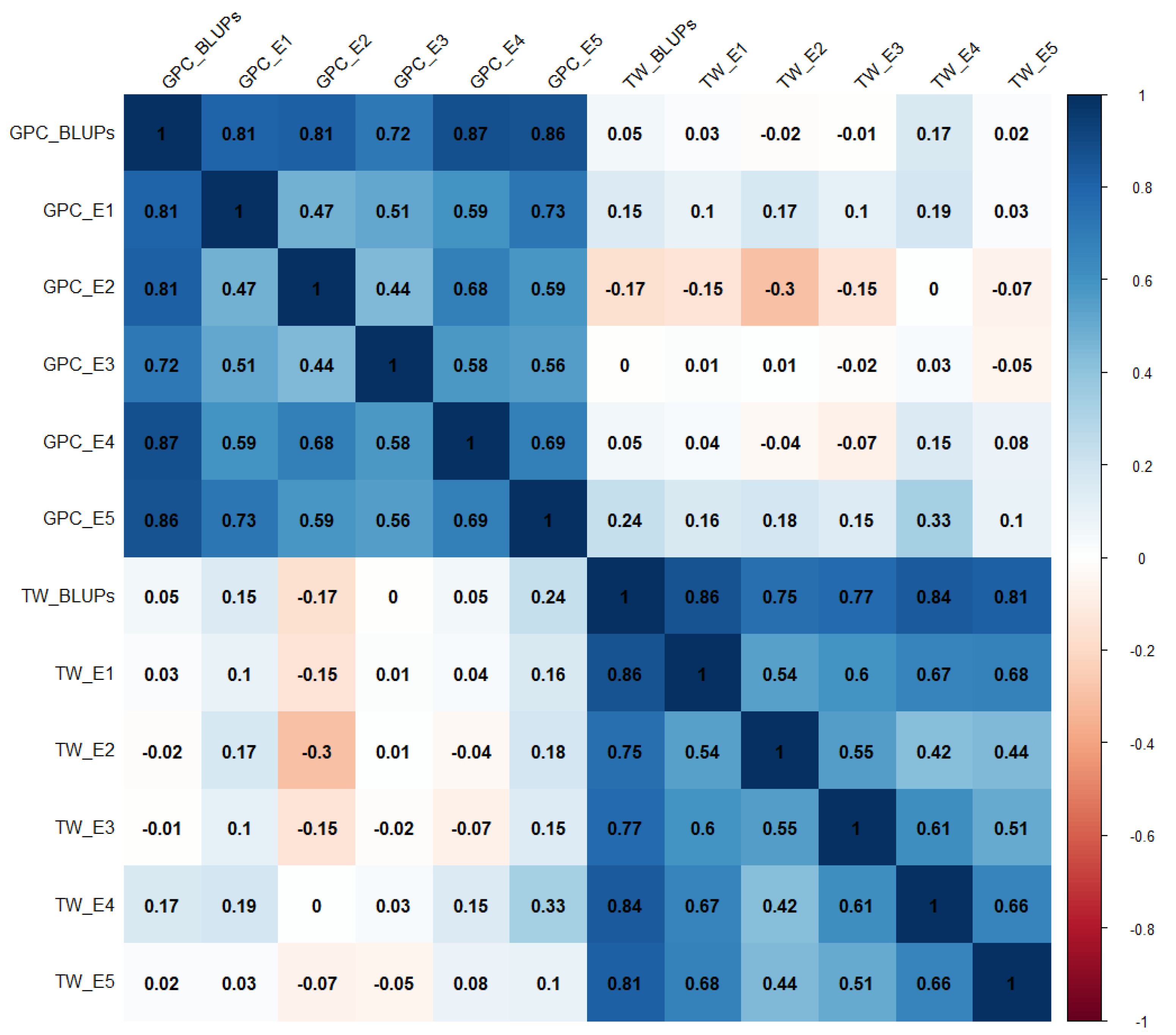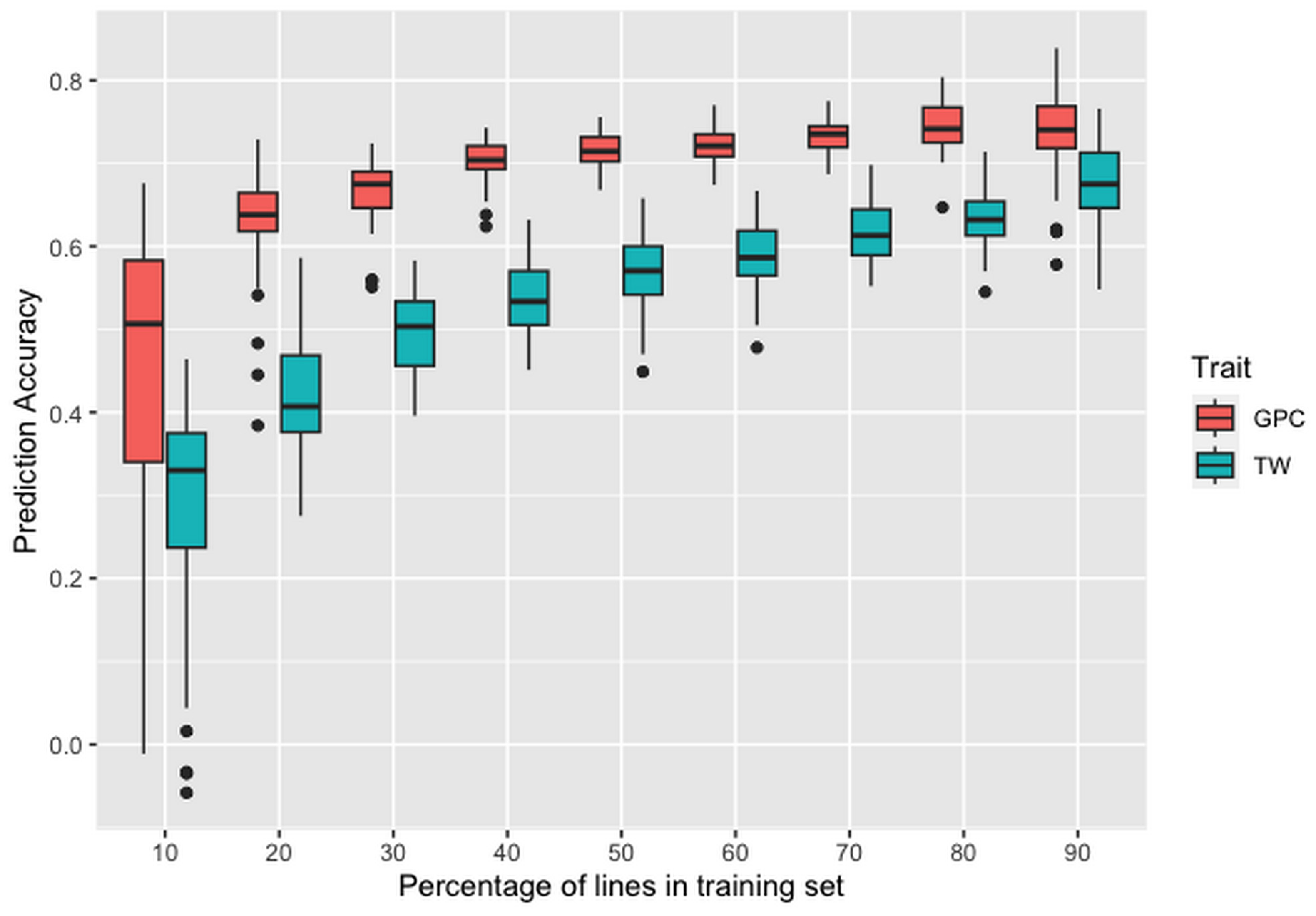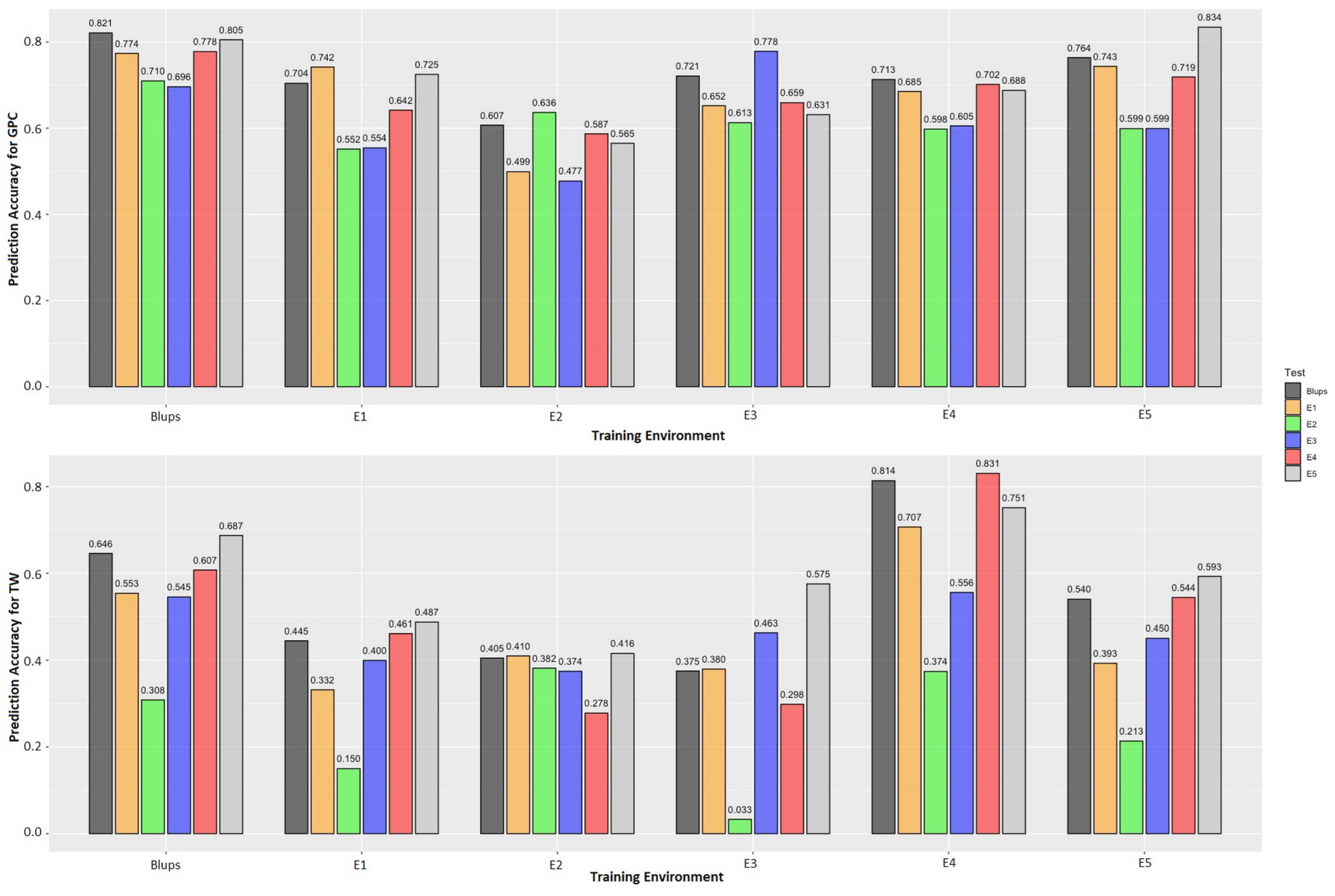An Optimal Model to Improve Genomic Prediction for Protein Content and Test Weight in a Diverse Spring Wheat Panel
Abstract
:1. Introduction
2. Materials and Methods
2.1. Plant Genetic Material
2.2. Phenotypic Evaluation
2.3. Phenotypic Data Analysis
2.4. Correlation and Principal Component Analyses
2.5. Genotyping
2.6. Genomic Prediction Model Selection
2.6.1. Genomic Best Linear Unbiased Prediction (GBLUP)
2.6.2. Epistatic Genomic Best Linear Unbiased Prediction (EGBLUP)
2.6.3. Ridge Regression Best Linear Unbiased Prediction (RRBLUP)
2.6.4. Reproducing Kernel Hilbert Space (RKHS)
2.6.5. Random Forest (RF)
2.7. Cross-Validation
3. Results
3.1. Phenotypic Evaluation
3.2. Correlation and Principal Component Analysis
3.3. Genotypic Data
3.4. Genomic Prediction Model Selection
3.5. Testing Prediction across Environment
4. Discussion
5. Conclusions
Supplementary Materials
Author Contributions
Funding
Institutional Review Board Statement
Data Availability Statement
Conflicts of Interest
References
- FAOSTAT—Statistical Databases. Food and Agriculture Organization of the United Nations. Available online: https://www.fao.org/faostat/en/#data/QCL (accessed on 7 July 2023).
- Shewry, P.R.; Hey, S.J. The Contribution of Wheat to Human Diet and Health. Food Energy Secur. 2015, 4, 178–202. [Google Scholar] [CrossRef]
- FAO. Available online: https://www.fas.usda.gov/data/commodities/wheat (accessed on 7 July 2023).
- Simons, K.; Anderson, J.A.; Mergoum, M.; Faris, J.D.; Klindworth, D.L.; Xu, S.S.; Sneller, C.; Ohm, J.-B.; Hareland, G.A.; Edwards, M.C.; et al. Genetic Mapping Analysis of Bread-Making Quality Traits in Spring Wheat. Crop Sci. 2012, 52, 2182–2197. [Google Scholar] [CrossRef]
- Nehe, A.; Akin, B.; Sanal, T.; Evlice, A.K.; Ünsal, R.; Dinçer, N.; Demir, L.; Geren, H.; Sevim, I.; Orhan, Ş.; et al. Genotype x Environment Interaction and Genetic Gain for Grain Yield and Grain Quality Traits in Turkish Spring Wheat Released between 1964 and 2010. PLoS ONE 2019, 14, e0219432. [Google Scholar] [CrossRef]
- Tilley, M.; Chen, Y.R.; Miller, R.A. 9—Wheat Breeding and Quality Evaluation in the US. In Breadmaking, 2nd ed.; Cauvain, S.P., Ed.; Woodhead Publishing Series in Food Science, Technology and Nutrition; Woodhead Publishing: Cambridge, UK, 2012; pp. 216–236. ISBN 978-0-85709-060-7. [Google Scholar]
- Wang, X.; Xu, Y.; Hu, Z.; Xu, C. Genomic Selection Methods for Crop Improvement: Current Status and Prospects. Crop J. 2018, 6, 330–340. [Google Scholar] [CrossRef]
- Smith, G.P.; Gooding, M.J. Models of Wheat Grain Quality Considering Climate, Cultivar and Nitrogen Effects. Agric. For. Meteorol. 1999, 94, 159–170. [Google Scholar] [CrossRef]
- Nuttall, J.G.; O’Leary, G.J.; Panozzo, J.F.; Walker, C.K.; Barlow, K.M.; Fitzgerald, G.J. Models of Grain Quality in Wheat—A Review. Field Crops Res. 2017, 202, 136–145. [Google Scholar] [CrossRef]
- Yamazaki, W.T.; Briggle, L.W. Components of Test Weight in Soft Wheat. Crop Sci. 1969, 9, 457–459. [Google Scholar] [CrossRef]
- Yabwalo, D.N.; Berzonsky, W.A.; Brabec, D.; Pearson, T.; Glover, K.D.; Kleinjan, J.L. Impact of Grain Morphology and the Genotype by Environment Interactions on Test Weight of Spring and Winter Wheat (Triticum aestivum L.). Euphytica 2018, 214, 125. [Google Scholar] [CrossRef]
- USDA; GIPSA; FGIS. Book II Grain Grading Procedures. In Grain Inspection Handbook; United States Department of Agriculture, Agricultural Marketing Service, Federal Grain Inspection Service: Washington, DC, USA, 2020. [Google Scholar]
- Schuler, S.F.; Bacon, R.K.; Finney, P.L.; Gbur, E.E. Relationship of Test Weight and Kernel Properties to Milling and Baking Quality in Soft Red Winter Wheat. Crop Sci. 1995, 35, 949–953. [Google Scholar] [CrossRef]
- Bordes, J.; Branlard, G.; Oury, F.X.; Charmet, G.; Balfourier, F. Agronomic Characteristics, Grain Quality and Flour Rheology of 372 Bread Wheats in a Worldwide Core Collection. J. Cereal Sci. 2008, 48, 569–579. [Google Scholar] [CrossRef]
- Shewry, P.R.; Halford, N.G.; Tatham, A.S.; Popineau, Y.; Lafiandra, D.; Belton, P.S. The High Molecular Weight Subunits of Wheat Glutenin and Their Role in Determining Wheat Processing Properties. Adv. Food Nutr. Res. 2003, 45, 219–302. [Google Scholar] [CrossRef] [PubMed]
- Uauy, C.; Brevis, J.C.; Dubcovsky, J. The High Grain Protein Content Gene Gpc-B1 Accelerates Senescence and Has Pleiotropic Effects on Protein Content in Wheat. J. Exp. Bot. 2006, 57, 2785–2794. [Google Scholar] [CrossRef] [PubMed]
- Shewry, P.R. Wheat. J. Exp. Bot. 2009, 60, 1537–1553. [Google Scholar] [CrossRef] [PubMed]
- Michel, S.; Löschenberger, F.; Ametz, C.; Pachler, B.; Sparry, E.; Bürstmayr, H. Combining Grain Yield, Protein Content and Protein Quality by Multi-Trait Genomic Selection in Bread Wheat. Theor. Appl. Genet. 2019, 132, 2767–2780. [Google Scholar] [CrossRef]
- Heslot, N.; Jannink, J.-L.; Sorrells, M.E. Perspectives for Genomic Selection Applications and Research in Plants. Crop Sci. 2015, 55, 1–12. [Google Scholar] [CrossRef]
- Tomar, V.; Singh, D.; Dhillon, G.S.; Chung, Y.S.; Poland, J.; Singh, R.P.; Joshi, A.K.; Gautam, Y.; Tiwari, B.S.; Kumar, U. Increased Predictive Accuracy of Multi-Environment Genomic Prediction Model for Yield and Related Traits in Spring Wheat (Triticum aestivum L.). Front. Plant Sci. 2021, 12, 720123. [Google Scholar] [CrossRef]
- Piepho, H.P.; Möhring, J.; Melchinger, A.E.; Büchse, A. BLUP for Phenotypic Selection in Plant Breeding and Variety Testing. Euphytica 2008, 161, 209–228. [Google Scholar] [CrossRef]
- Arruda, M.P.; Lipka, A.E.; Brown, P.J.; Krill, A.M.; Thurber, C.; Brown-Guedira, G.; Dong, Y.; Foresman, B.J.; Kolb, F.L. Comparing Genomic Selection and Marker-Assisted Selection for Fusarium Head Blight Resistance in Wheat (Triticum aestivum L.). Mol. Breed. 2016, 36, 84. [Google Scholar] [CrossRef]
- Kumar, A.; Jain, S.; Elias, E.M.; Ibrahim, M.; Sharma, L.K. An Overview of QTL Identification and Marker-Assisted Selection for Grain Protein Content in Wheat. In Eco-Friendly Agro-Biological Techniques for Enhancing Crop Productivity; Sengar, R.S., Singh, A., Eds.; Springer: Singapore, 2018; pp. 245–274. ISBN 978-981-10-6933-8. [Google Scholar]
- Beukert, U.; Thorwarth, P.; Zhao, Y.; Longin, C.F.H.; Serfling, A.; Ordon, F.; Reif, J.C. Comparing the Potential of Marker-Assisted Selection and Genomic Prediction for Improving Rust Resistance in Hybrid Wheat. Front. Plant Sci. 2020, 11, 594113. [Google Scholar] [CrossRef]
- Bernardo, R. Molecular Markers and Selection for Complex Traits in Plants: Learning from the Last 20 Years. Crop Sci. 2008, 48, 1649–1664. [Google Scholar] [CrossRef]
- He, J.; Zhao, X.; Laroche, A.; Lu, Z.-X.; Liu, H.; Li, Z. Genotyping-by-Sequencing (GBS), an Ultimate Marker-Assisted Selection (MAS) Tool to Accelerate Plant Breeding. Front. Plant Sci. 2014, 5, 484. [Google Scholar] [CrossRef] [PubMed]
- Combs, E.; Bernardo, R. Accuracy of Genomewide Selection for Different Traits with Constant Population Size, Heritability, and Number of Markers. Plant Genome 2013, 6, 1–7. [Google Scholar] [CrossRef]
- Meuwissen, T.H.; Hayes, B.J.; Goddard, M.E. Prediction of Total Genetic Value Using Genome-Wide Dense Marker Maps. Genetics 2001, 157, 1819–1829. [Google Scholar] [CrossRef] [PubMed]
- Zhang, A.; Wang, H.; Beyene, Y.; Semagn, K.; Liu, Y.; Cao, S.; Cui, Z.; Ruan, Y.; Burgueño, J.; San Vicente, F.; et al. Effect of Trait Heritability, Training Population Size and Marker Density on Genomic Prediction Accuracy Estimation in 22 Bi-Parental Tropical Maize Populations. Front. Plant Sci. 2017, 8, 1916. [Google Scholar] [CrossRef] [PubMed]
- Bassi, F.M.; Bentley, A.R.; Charmet, G.; Ortiz, R.; Crossa, J. Breeding Schemes for the Implementation of Genomic Selection in Wheat (Triticum Spp.). Plant Sci. 2016, 242, 23–36. [Google Scholar] [CrossRef] [PubMed]
- Sandhu, K.S.; Mihalyov, P.D.; Lewien, M.J.; Pumphrey, M.O.; Carter, A.H. Genomic Selection and Genome-Wide Association Studies for Grain Protein Content Stability in a Nested Association Mapping Population of Wheat. Agronomy 2021, 11, 2528. [Google Scholar] [CrossRef]
- Juliana, P.; Singh, R.P.; Braun, H.-J.; Huerta-Espino, J.; Crespo-Herrera, L.; Govindan, V.; Mondal, S.; Poland, J.; Shrestha, S. Genomic Selection for Grain Yield in the CIMMYT Wheat Breeding Program—Status and Perspectives. Front. Plant Sci. 2020, 11, 564183. [Google Scholar] [CrossRef] [PubMed]
- Brauner, P.C.; Müller, D.; Molenaar, W.S.; Melchinger, A.E. Genomic Prediction with Multiple Biparental Families. Theor. Appl. Genet. 2020, 133, 133–147. [Google Scholar] [CrossRef] [PubMed]
- Guzman, C.; Peña, R.J.; Singh, R.; Autrique, E.; Dreisigacker, S.; Crossa, J.; Rutkoski, J.; Poland, J.; Battenfield, S. Wheat Quality Improvement at CIMMYT and the Use of Genomic Selection on It. Appl. Transl. Genom. 2016, 11, 3–8. [Google Scholar] [CrossRef]
- Haile, T.A.; Walkowiak, S.; N’Diaye, A.; Clarke, J.M.; Hucl, P.J.; Cuthbert, R.D.; Knox, R.E.; Pozniak, C.J. Genomic Prediction of Agronomic Traits in Wheat Using Different Models and Cross-Validation Designs. Theor. Appl. Genet. 2021, 134, 381–398. [Google Scholar] [CrossRef]
- Martini, J.W.R.; Gao, N.; Cardoso, D.F.; Wimmer, V.; Erbe, M.; Cantet, R.J.C.; Simianer, H. Genomic Prediction with Epistasis Models: On the Marker-Coding-Dependent Performance of the Extended GBLUP and Properties of the Categorical Epistasis Model (CE). BMC Bioinform. 2017, 18, 3. [Google Scholar] [CrossRef] [PubMed]
- Wang, R.; Chen, J.; Anderson, J.A.; Zhang, J.; Zhao, W.; Wheeler, J.; Klassen, N.; See, D.R.; Dong, Y. Genome-Wide Association Mapping of Fusarium Head Blight Resistance in Spring Wheat Lines Developed in the Pacific Northwest and CIMMYT. Phytopathology 2017, 107, 1486–1495. [Google Scholar] [CrossRef] [PubMed]
- Dong, H.; Wang, R.; Yuan, Y.; Anderson, J.; Pumphrey, M.; Zhang, Z.; Chen, J. Evaluation of the Potential for Genomic Selection to Improve Spring Wheat Resistance to Fusarium Head Blight in the Pacific Northwest. Front. Plant Sci. 2018, 9, 911. [Google Scholar] [CrossRef] [PubMed]
- Alvarado, G.; Rodríguez, F.M.; Pacheco, A.; Burgueño, J.; Crossa, J.; Vargas, M.; Pérez-Rodríguez, P.; Lopez-Cruz, M.A. META-R: A Software to Analyze Data from Multi-Environment Plant Breeding Trials. Crop J. 2020, 8, 745–756. [Google Scholar] [CrossRef]
- Wickham, H. Ggplot2: Elegant Graphics for Data Analysis, 2nd ed.; Wickham, H., Ed.; Springer: New York, NY, USA, 2016; ISBN 978-3-319-24275-0. [Google Scholar]
- Kassambara, A. Ggpubr: ‘Ggplot2′ Based Publication Ready Plots. 2020. Available online: https://rpkgs.datanovia.com/ggpubr/ (accessed on 7 July 2023).
- Wei, T.; Simko, V. R Package “Corrplot”: Visualization of a Correlation Matrix. 2021. Available online: https://cran.r-project.org/web/packages/corrplot/index.html (accessed on 7 July 2023).
- Lê, S.; Josse, J.; Husson, F. FactoMineR: An R Package for Multivariate Analysis. J. Stat. Softw. 2008, 25, 1–18. [Google Scholar] [CrossRef]
- Kassambara, A.; Mundt, F. Factoextra: Extract and Visualize the Results of Multivariate Data Analyses. 2020, pp. 1–84. Available online: https://cran.r-project.org/package=factoextra (accessed on 7 July 2023).
- Illumina GenomeStudio Genotyping Module 2010. Available online: https://www.illumina.com/techniques/microarrays/array-data-analysis-experimental-design/genomestudio.html (accessed on 7 July 2023).
- Bradbury, P.J.; Zhang, Z.; Kroon, D.E.; Casstevens, T.M.; Ramdoss, Y.; Buckler, E.S. TASSEL: Software for Association Mapping of Complex Traits in Diverse Samples. Bioinformatics 2007, 23, 2633–2635. [Google Scholar] [CrossRef] [PubMed]
- Charmet, G.; Tran, L.-G.; Auzanneau, J.; Rincent, R.; Bouchet, S. BWGS: A R Package for Genomic Selection and Its Application to a Wheat Breeding Programme. PLoS ONE 2020, 15, e0222733. [Google Scholar] [CrossRef]
- Habier, D.; Fernando, R.L.; Dekkers, J.C.M. The Impact of Genetic Relationship Information on Genome-Assisted Breeding Values. Genetics 2007, 177, 2389–2397. [Google Scholar] [CrossRef]
- VanRaden, P.M. Efficient Methods to Compute Genomic Predictions. J. Dairy Sci. 2008, 91, 4414–4423. [Google Scholar] [CrossRef]
- Jiang, Y.; Reif, J.C. Modeling Epistasis in Genomic Selection. Genetics 2015, 201, 759–768. [Google Scholar] [CrossRef]
- Gianola, D.; van Kaam, J.B.C.H.M. Reproducing Kernel Hilbert Spaces Regression Methods for Genomic Assisted Prediction of Quantitative Traits. Genetics 2008, 178, 2289–2303. [Google Scholar] [CrossRef]
- de los Campos, G.; Naya, H.; Gianola, D.; Crossa, J.; Legarra, A.; Manfredi, E.; Weigel, K.; Cotes, J.M. Predicting Quantitative Traits with Regression Models for Dense Molecular Markers and Pedigree. Genetics 2009, 182, 375–385. [Google Scholar] [CrossRef]
- Breiman, L. Random Forests. Mach. Learn. 2001, 45, 5–32. [Google Scholar] [CrossRef]
- Shah, S.H.; Angel, Y.; Houborg, R.; Ali, S.; McCabe, M.F. A Random Forest Machine Learning Approach for the Retrieval of Leaf Chlorophyll Content in Wheat. Remote Sens. 2019, 11, 920. [Google Scholar] [CrossRef]
- Tessema, B.B.; Liu, H.; Sørensen, A.C.; Andersen, J.R.; Jensen, J. Strategies Using Genomic Selection to Increase Genetic Gain in Breeding Programs for Wheat. Front. Genet. 2020, 11, 578123. [Google Scholar] [CrossRef]
- Cobb, J.N.; Biswas, P.S.; Platten, J.D. Back to the Future: Revisiting MAS as a Tool for Modern Plant Breeding. Theor. Appl. Genet. 2019, 132, 647–667. [Google Scholar] [CrossRef]
- Hyles, J.; Bloomfield, M.T.; Hunt, J.R.; Trethowan, R.M.; Trevaskis, B. Phenology and Related Traits for Wheat Adaptation. Heredity 2020, 125, 417–430. [Google Scholar] [CrossRef] [PubMed]
- Purugganan, M.D.; Jackson, S.A. Advancing Crop Genomics from Lab to Field. Nat. Genet. 2021, 53, 595–601. [Google Scholar] [CrossRef] [PubMed]
- Gondro, C.; Van Der Werf, J.; Hayes, B. (Eds.) Genome-Wide Association Studies and Genomic Prediction; Methods in Molecular Biology; Humana Press: Totowa, NJ, USA, 2013; Volume 1019, ISBN 978-1-62703-446-3. [Google Scholar]
- Kumar, M.; Kumar, S.; Sandhu, K.S.; Kumar, N.; Saripalli, G.; Prakash, R.; Nambardar, A.; Sharma, H.; Gautam, T.; Balyan, H.S.; et al. GWAS and Genomic Prediction for Pre-Harvest Sprouting Tolerance in Spring Wheat. Mol. Breed. 2023, 43, 14. [Google Scholar] [CrossRef] [PubMed]
- Hayes, B.J.; Bowman, P.J.; Chamberlain, A.C.; Verbyla, K.; Goddard, M.E. Accuracy of Genomic Breeding Values in Multi-Breed Dairy Cattle Populations. Genet. Sel. Evol. 2009, 41, 51. [Google Scholar] [CrossRef] [PubMed]
- Dekkers, J.C.M.; Su, H.; Cheng, J. Predicting the Accuracy of Genomic Predictions. Genet. Sel. Evol. 2021, 53, 55. [Google Scholar] [CrossRef]
- Semagn, K.; Iqbal, M.; Jarquin, D.; Randhawa, H.; Aboukhaddour, R.; Howard, R.; Ciechanowska, I.; Farzand, M.; Dhariwal, R.; Hiebert, C.W.; et al. Genomic Prediction Accuracy of Stripe Rust in Six Spring Wheat Populations by Modeling Genotype by Environment Interaction. Plants 2022, 11, 1736. [Google Scholar] [CrossRef]
- Groos, C.; Robert, N.; Bervas, E.; Charmet, G. Genetic Analysis of Grain Protein-Content, Grain Yield and Thousand-Kernel Weight in Bread Wheat. Theor. Appl. Genet. 2003, 106, 1032–1040. [Google Scholar] [CrossRef]
- Miezan, K.; Heyne, E.G.; Finney, K.F. Genetic and Environmental Effects on the Grain Protein Content in Wheat. Crop Sci. 1977, 17, 591–593. [Google Scholar] [CrossRef]
- Syltie, P.W.; Dahnke, W.C. Mineral and Protein Content, Test Weight, and Yield Variations of Hard Red Spring Wheat Grain as Influenced by Fertilization and Cultivar. Plant Food Hum. Nutr. 1983, 32, 37–49. [Google Scholar] [CrossRef]
- White, J.; Sharma, R.; Balding, D.; Cockram, J.; Mackay, I.J. Genome-Wide Association Mapping of Hagberg Falling Number, Protein Content, Test Weight, and Grain Yield in U.K. Wheat. Crop Sci. 2022, 62, 965–981. [Google Scholar] [CrossRef]
- Hadfield, J.; Wilson, A.; Garant, D.; Sheldon, B.; Kruuk, L. The Misuse of BLUP in Ecology and Evolution. Am. Nat. 2009, 175, 116–125. [Google Scholar] [CrossRef] [PubMed]
- Dhillon, G.S.; Das, N.; Kaur, S.; Shrivastava, P.; Bains, N.S.; Chhuneja, P. Marker Assisted Mobilization of Heat Tolerance QTLs from Triticum durum-Aegilops Speltoides Introgression Lines to Hexaploid Wheat. Indian J. Genet. Plant Breed. 2021, 81, 186–198. [Google Scholar] [CrossRef]
- Tomar, V.; Dhillon, G.; Singh, D.; Poland, J.; Chaudhary, A.; Bhati, P.; Joshi, A. Evaluations of Genomic Prediction and Identification of New Loci for Resistance to Stripe Rust Disease in Wheat (Triticum aestivum L.). Front. Genet. 2021, 12, 710485. [Google Scholar] [CrossRef] [PubMed]
- Huang, M.; Cabrera, A.; Hoffstetter, A.; Griffey, C.; Van Sanford, D.; Costa, J.; McKendry, A.; Chao, S.; Sneller, C. Genomic Selection for Wheat Traits and Trait Stability. Theor. Appl. Genet. 2016, 129, 1697–1710. [Google Scholar] [CrossRef] [PubMed]
- Rabieyan, E.; Darvishzadeh, R.; Alipour, H. Genetic Analyses and Prediction for Lodging-related Traits in a Diverse Iranian Hexaploid Wheat Collection. Sci. Rep. 2024, 14, 275. [Google Scholar] [CrossRef]
- Lozada, D.N.; Carter, A.H. Genomic Selection in Winter Wheat Breeding Using a Recommender Approach. Genes 2020, 11, 779. [Google Scholar] [CrossRef]
- Belamkar, V.; Guttieri, M.J.; Hussain, W.; Jarquín, D.; El-basyoni, I.; Poland, J.; Lorenz, A.J.; Baenziger, P.S. Genomic Selection in Preliminary Yield Trials in a Winter Wheat Breeding Program. G3 Genes Genomes Genet. 2018, 8, 2735–2747. [Google Scholar] [CrossRef]
- Endelman, J.B. Ridge Regression and Other Kernels for Genomic Selection with R Package rrBLUP. Plant Genome 2011, 4, 255–258. [Google Scholar] [CrossRef]
- Wientjes, Y.C.J.; Bijma, P.; Calus, M.P.L.; Zwaan, B.J.; Vitezica, Z.G.; van den Heuvel, J. The Long-Term Effects of Genomic Selection: 1. Response to Selection, Additive Genetic Variance, and Genetic Architecture. Genet. Sel. Evol. 2022, 54, 19. [Google Scholar] [CrossRef]
- Cericola, F.; Jahoor, A.; Orabi, J.; Andersen, J.R.; Janss, L.L.; Jensen, J. Optimizing Training Population Size and Genotyping Strategy for Genomic Prediction Using Association Study Results and Pedigree Information. A Case of Study in Advanced Wheat Breeding Lines. PLoS ONE 2017, 12, e0169606. [Google Scholar] [CrossRef] [PubMed]
- Berro, I.; Lado, B.; Nalin, R.S.; Quincke, M.; Gutiérrez, L. Training Population Optimization for Genomic Selection. Plant Genome 2019, 12, 190028. [Google Scholar] [CrossRef] [PubMed]






Disclaimer/Publisher’s Note: The statements, opinions and data contained in all publications are solely those of the individual author(s) and contributor(s) and not of MDPI and/or the editor(s). MDPI and/or the editor(s) disclaim responsibility for any injury to people or property resulting from any ideas, methods, instructions or products referred to in the content. |
© 2024 by the authors. Licensee MDPI, Basel, Switzerland. This article is an open access article distributed under the terms and conditions of the Creative Commons Attribution (CC BY) license (https://creativecommons.org/licenses/by/4.0/).
Share and Cite
Joshi, P.; Dhillon, G.S.; Gao, Y.; Kaur, A.; Wheeler, J.; Chen, J. An Optimal Model to Improve Genomic Prediction for Protein Content and Test Weight in a Diverse Spring Wheat Panel. Agriculture 2024, 14, 347. https://doi.org/10.3390/agriculture14030347
Joshi P, Dhillon GS, Gao Y, Kaur A, Wheeler J, Chen J. An Optimal Model to Improve Genomic Prediction for Protein Content and Test Weight in a Diverse Spring Wheat Panel. Agriculture. 2024; 14(3):347. https://doi.org/10.3390/agriculture14030347
Chicago/Turabian StyleJoshi, Pabitra, Guriqbal Singh Dhillon, Yaotian Gao, Amandeep Kaur, Justin Wheeler, and Jianli Chen. 2024. "An Optimal Model to Improve Genomic Prediction for Protein Content and Test Weight in a Diverse Spring Wheat Panel" Agriculture 14, no. 3: 347. https://doi.org/10.3390/agriculture14030347





